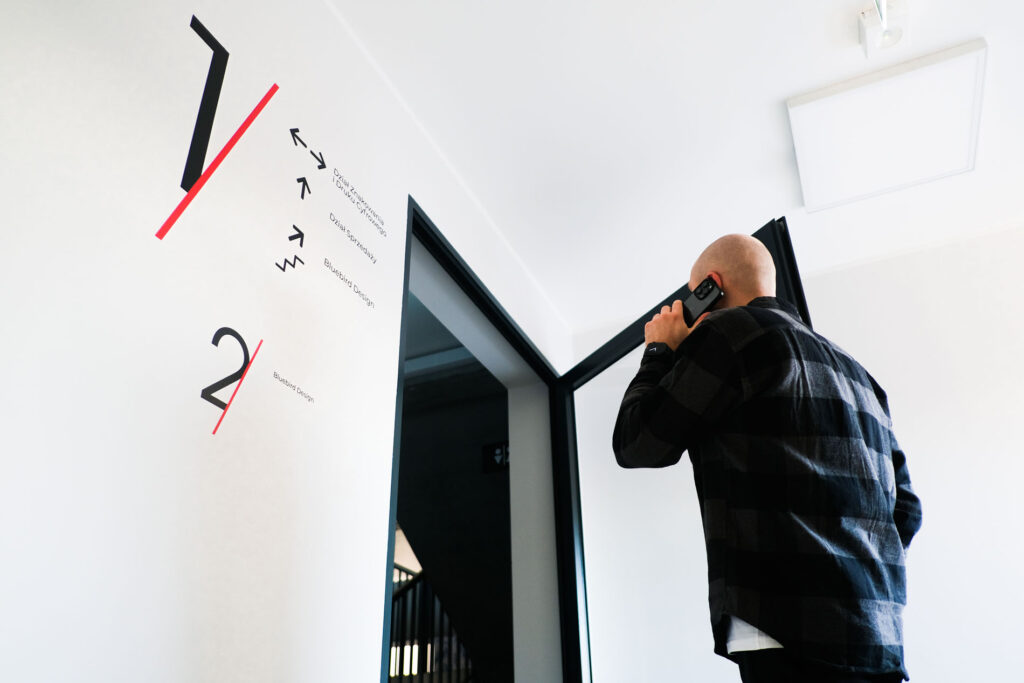Key information:
Relevant systems such as wayfinding (space navigation), space branding (consistency with corporate identity) and signage (comprehensive signage ), serve an extremely important function by improving orientation and comfort. But does the implementation of sign age always have to be a significant budget challenge?
In this article, we will suggest how to avoid this without sacrificing quality.

Functionality and compliance with health and safety standards
Interior signage should be practical and contribute to the ergonomics and efficiency of movement in a building, which of course will translate in the case of, for example, office space, into work comfort and productivity.
All signage elements should form a unified, aesthetically pleasing whole that is easy to understand.
Signs must also comply with all health and safety regulations.

Consistency with the brand's visual identity
Consistency of signage with a brand’s visual identity is an important part of building a strong corporate image. Every element of the signage, from the color scheme to the typography to the graphic style, should reflect the brand identity, which strengthens its recognition and prestige.
In this way, signage becomes not only a practical tool, but also an important element of marketing and communication strategy. In the long run, the consistent use of corporate identity in all aspects of a company’s operations (including signage), supports the building of a lasting and positive brandreputation in the market.

Interior signage vs. exterior architecture of the facility
It would seem that the consistency of signage with the architecture of the building is obvious and indispensable for creating a harmonious and aesthetically pleasing space.
However, let’s try to look at this issue in two different ways.
Integrating signage with architecture can highlight a building’s unique features, such as its history, style or innovative design.
As a result, the space becomes more valuable, and users have a better experience in perceiving it.
Matching signage to a building’s architecture highlights its unique character while harmonizing with its style, which can create a cohesive and pleasing environment.
However, let’s imagine a completely different scenario, when, for example, a stately, newly renovated townhouse houses modern office space.
In such a case, are we doomed to a “retro” style of designed signage?
Of course not! Breaking the style, a kind of eclecticism or playing with the form is nothing wrong here.
In our view, the key is to match wayfinding with the interior design and visual identity of the brand.
The type of signage material used (plastic vs. natural materials), as well as the scale of the project, have the greatest impact on the cost of the overall project.

Quality of workmanship and type of materials.
What about the budget version?
“As they see you, so they write you”. – this well-known adage perfectly fits the idea behind the idea of properly understood wayfinding.
Effective, well-crafted and properly installed signage increases brand credibility, showing that the company cares about every detail of its visual communication.
Modern production technologies, such as digital printing, allow the implementation of complex signage projects on a variety of materials, and it is the type of material used for the signage that has a significant impact on the budget of the entire project. Materials such as wood, glass, aluminum or stainless steel are more expensive to purchase (raw material), process (laser cutting) , as well as to install due totheir heavier weight .
An excellent alternative is foamed PVC, acrylic or various types of composites, that is, materials made of plastic (often recycled).
They feature a very good price/quality ratio, are durable, lightweight, resistant to light or weather conditions and, most importantly , allow you to achieve a great end result.
Of course, natural materials should not be disavowed, which will certainly look just as good, and in some situations their use is even required (such as stainless steel in contact with rain for outdoor signage in uncovered areas).
In summary, the type of signage material used depends most on the customer’s expectations, interior design and financial capabilities.

What does the implementation process look like?
Professional space signage should begin with a thorough audit and needs analysis. For this purpose, the consultant assesses the current state of the space, identifies the client’s needs and determines the optimal locations for the signs.
Based on the collected data, a detailed signage plan is created, taking into account legal regulations and user expectations.
The client receives a document containing proposals for the signs along with a map of their future locations.
Once the project is approved, the production and installation phase of the signs begins, concluding the whole thing with an evaluation of the completed work and the client’s formal approval.

We are One Stop Shop wayfinding
We have many years of experience in signage projects for various types of spaces, from office to industrial.
We carry out projects all over Europe, offering comprehensive solutions including both design, production and installation of signs.
Since we do not need subcontractors, the offer you receive will be the most favorable on the market.






